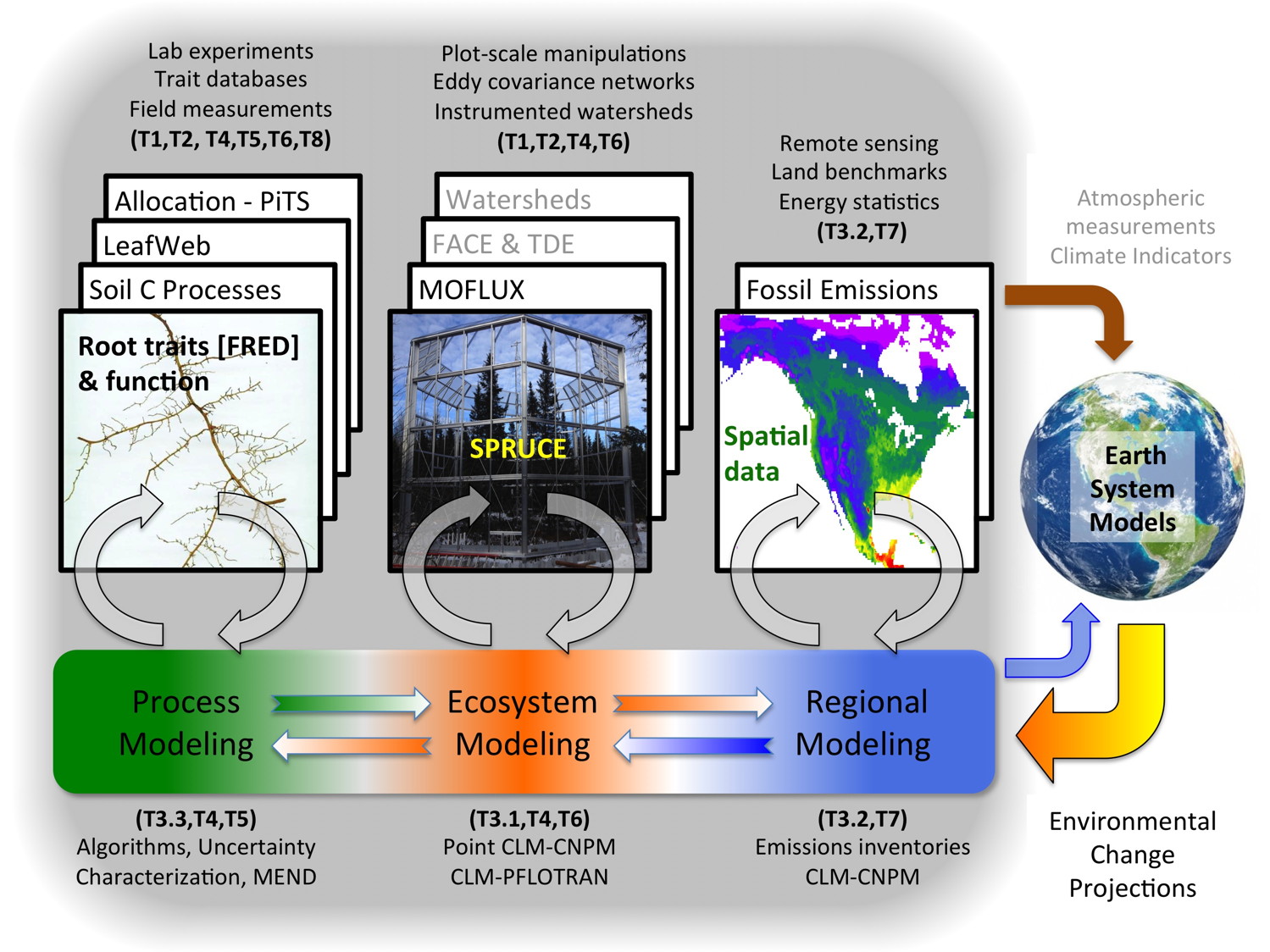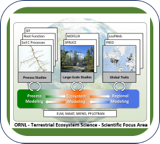This task integrates observations from past and current DOE-funded flagship experiments, observation networks, and related activities into models across spatial and temporal scales to identify and reduce terrestrial process and parameter uncertainties in the global climate-C system.
Our key goal is to convey new process knowledge from plot-level and focused model-data studies to improve climate prediction in an ESM, and to use modeling to inform new measurements.
A consistent modeling framework across scales is therefore essential. The TES SFA uses the Community Earth System Model (CESM), which has an extensive user base and development community and forms the foundation for the recently initiated Accelerated Climate Model for Energy (ACME). The Community Land Model (CLM) within the CESM framework provides the opportunity to integrate knowledge from across projects and institutions with the goal of improving climate predictions.
Subtask 3.1 outlines future plans for model development and testing ad the site scale
Subtask 3.2 outlines future plans for scaling these results to regional to global scales, and testing them with regional datasets.
SubTask 3.3 involves the development and application of a functional testing framework for CLM.

Diagram of the TES SFA research philosophy and flow illustrating an iterative exchange between model projections, question or hypothesis development and the execution of observations and experiments to better understand impacts of multi-factor environmental changes on ecosystems.
Task 3.1 – Improve ecosystem process models with site-level observations and experimental data
Site-level observations from numerous sources, including SPRUCE, FACE, and AmeriFlux are being used to inform CLM for the purpose of model evaluation and development. Many of these analyses indicate that current CLM representations of key C-Cycle processes are too simplistic, contributing to various biases in prediction. Here we are addressing a number of process improvements, including allocation, root function, wetland biogeochemistry, photosynthesis and soil C decomposition. Specifically, the model will be built and extensively tested at 3 supersites: The SPRUCE experimental site, the Missouri Ozark AmeriFlux site, and the Oak Ridge Reservation in Tennessee. The model will also be evaluated at other AmeriFlux and FLUXNET sites. An ecological forecasting system will be developed to predict future states and fluxes at these 3 sites using data assimilation with a probabilistic ensemble. CLM-PFLOTRAN will be also to conduct high-resolution 3D simulations of surface-subsurface flow and reactive transport at these sites. Specifically at SPRUCE, significant progress has been made in improving model representation of bog hydrology (Shi et al., 2015). A model intercomparison at SPRUCE is planned in 2016 to evaluate model responses to initial treatments.
Task 3.2 – Regional and global land ecosystem modeling
Large uncertainties remain in characterizing spatial and temporal patterns of carbon stocks and land-atmosphere fluxes. This is mainly because of the relative scarcity of in situ and regional observations, and the internal and external model uncertainties. The estimation of GPP remains highly uncertain. We are using a consistent model-data fusion framework to make more accurate predictions of global GPP using process improvements in task 3.1 in combination with a number of remote sensing and synthesis datasets to constrain uncertain model parameters. Model simulations that apply forcing factors in a factorial design have been useful for determining the influence of these factors on specific model outputs (Shi et al., 2013). This improved modeling system will increase the fidelity of the simulations and our confidence in attributing observed changes to natural and anthropogenic factors. We are applying the statistical methods of detection and attribution (D&A) to quantify the causes of multi-year changes in terrestrial GPP and other carbon cycle fluxes.
Task 3.3 – Functional testing
We are implementing a more interactive approach to establish user-defined models using existing functional modules within CLM, and designing a graphical user interface (GUI) to visualize this modeling system (Wang et al., 2014). We are working with experimentalists to develop software tools to address specific hypotheses with these modules. The functional testing framework allows also for the use of uncertainty quantification methods, addressing both parametric and structural uncertainty, that are not practical with the full model. Alternative functional units might describe alternative hypotheses for how individual processes operate, and encoding these within different models could be useful in diagnosing inter-model differences in multi-model intercomparisons.
References
- Shi X, Mao JF, Thornton PE, Huang MY (2013) Spatiotemporal patterns of evapotranspiration in response to multiple environmental factors simulated by the Community Land Model. Environmental Research Letters 8(2): 024012, doi:10.1088/1748-9326/8/2/024012.
- Shi X, Thornton PE, Ricciuto DM, Hanson PJ, Mao J, Sebestyen SD, Griffiths NA, Bisht G (2015) Representing northern peatland microtopography and hydrology within the Community Land Model. Biogeosciences Discussion, 12:1-38,doi:10.5194/bgd-12-3381-2015.
- Wang D, Xu Y, Thornton P, King A, Steed C, Gu LH, Schuchart J (2014) A functional testing platform for the Community Land Model. Environmental Modeling and Software 55:25-31, doi:10.1016/j.envsoft.2014.01.015.

